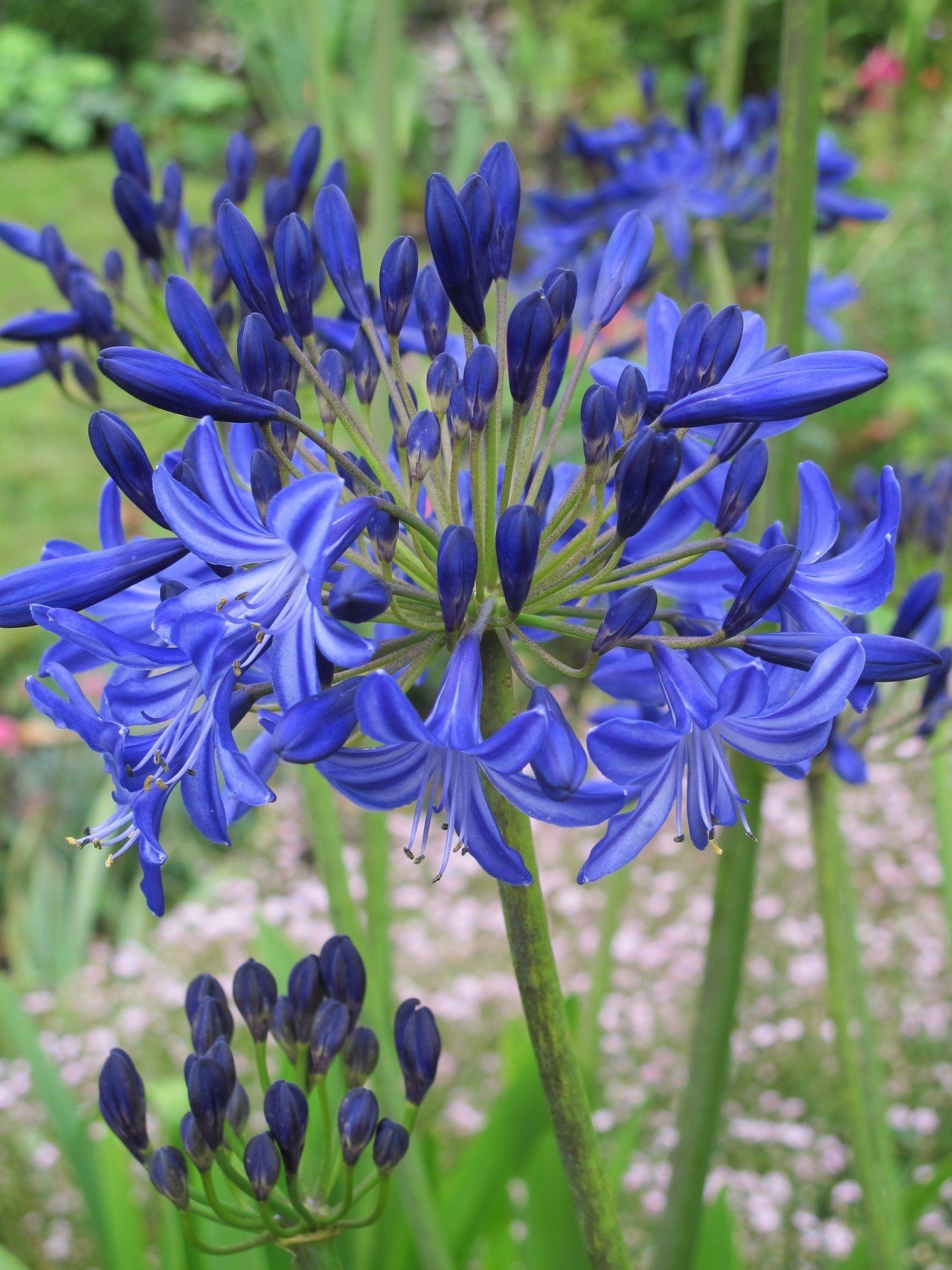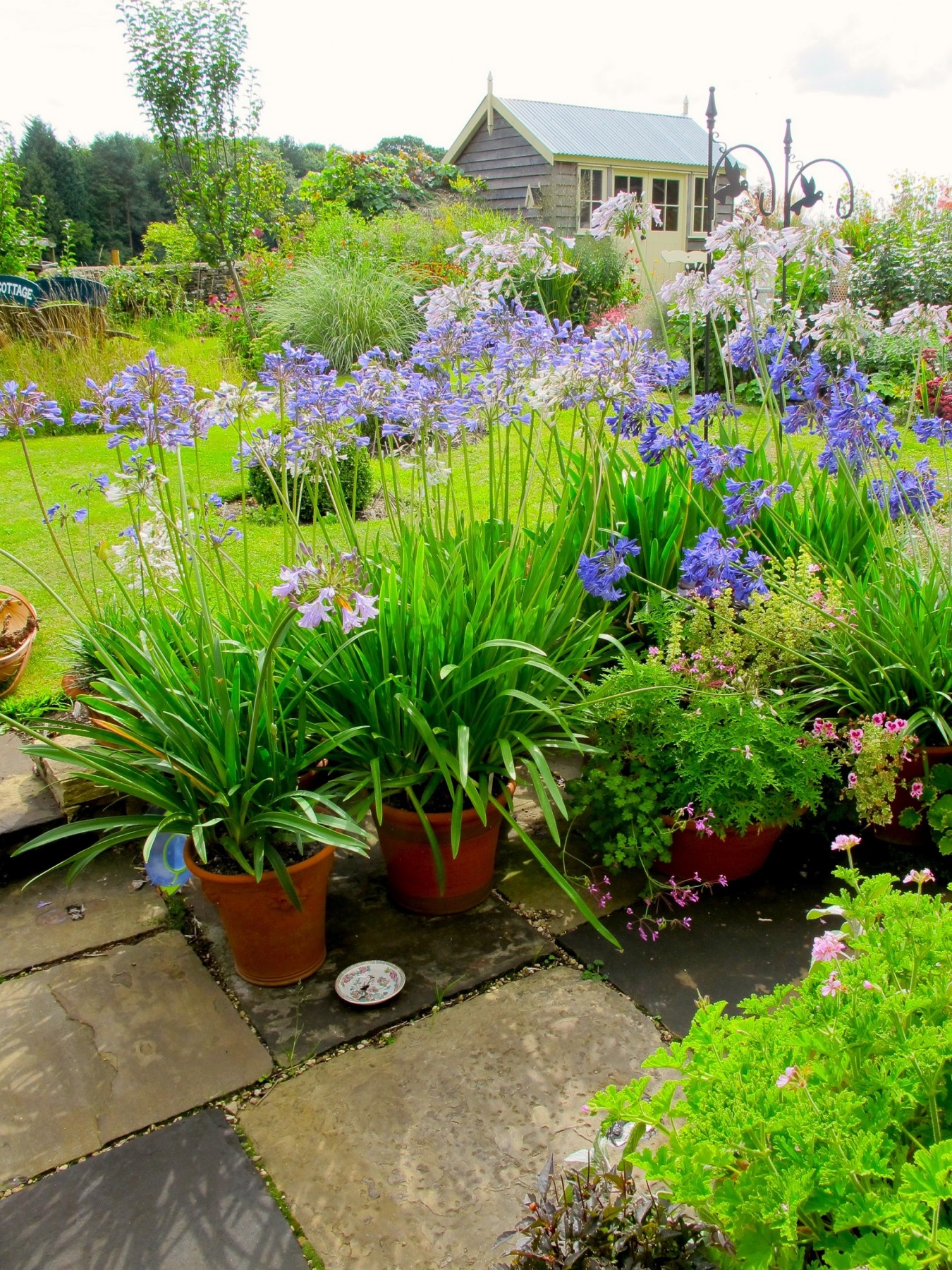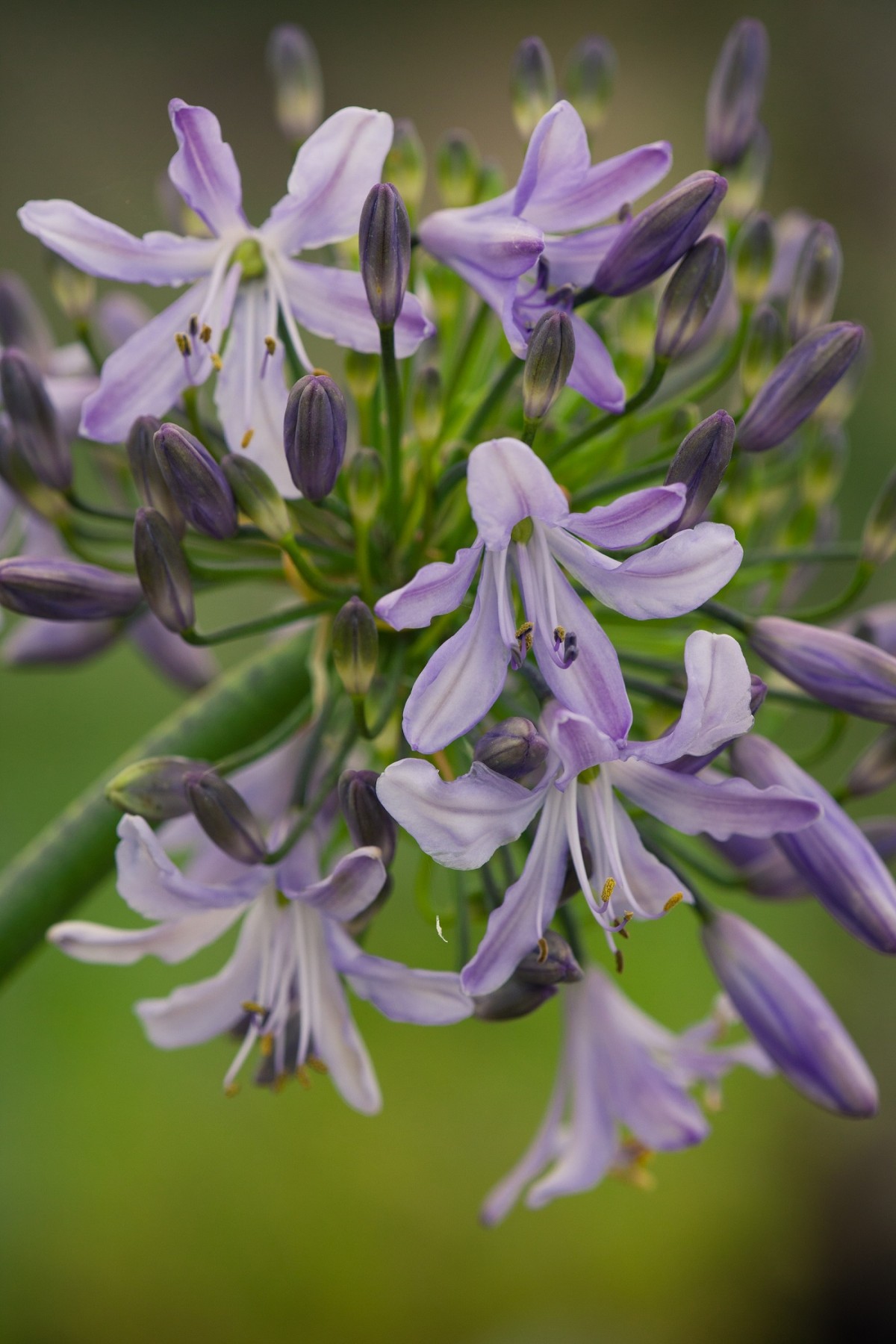
True-blue is an evening star because it glows as night falls. I’m not talking cottage-garden, wishy-washy, ‘so-called blues’ in shades that hover between mauve, lavender and grey. Many campanulas, lavenders and hardy geraniums, for instance, come in these softer colours but tend to look a milky grey in evening light. Radiant blues, on the other hand, almost vibrate when you look at them and an agapanthus, grown in a sturdy and stable terracotta pot that can be moved round the garden as needed, is the prefect plant for adding this electrifying touch to your planting.
My fourteen potfuls are arranged along the south-facing front wall of Spring Cottage, about six feet ( or 2m ) away from the house. They peak from July onwards in, various shades of blue, and are highly admired by visitors and passers by. They all have umbel-like heads of thickly-petalled flowers that wave about on rubbery stems, because these plants have evolved to resist the gusty winds and strong sunshine found on The Cape, a rugged area of South Africa that enjoys an average of between 8 and 10 hours of sunshine every day.
Agapanthus species grow naturally on both sides of The Cape and both regions enjoy one season of high rainfall, so the one thing all agapanthus need is copious water during their growing season. We often water here twice a day in June, July and August and we also feed them with a liquid, high-potash tomato food, applied every two weeks. In September we ease off the watering and feeding and our potfuls are moved into our unheated greenhouse during winter and then left to their own devices. Watering begins again in spring, usually mid-March here.
It’s noticeable that some of our named varieties have an evergreen tendency, whilst others are deciduous. Generally evergreen agapanthus have wider foliage and are less hardy than those that die down in winter. The difference is due to their breeding line and where the plants in their breeding line originated from. Agapanthus species found on the eastern side of The Cape have a four-month wet, summer season between November and February , when rainfall averages 5 inches per month (125m). The winters, between May and August, are dry and cool however. As a result agapanthus species from the eastern side tend to do their growing in the summer and then die down in winter. The foliage tends to be slender and neater to look at.

The western Cape, on the other hand, has a Mediterranean climate that produces a moist damp winter, between May and August, followed by a hot, dry summer between November and January. Agapanthus species found on the western side grow in winter, when moisture and warmth are more available, so they keep their lush, wide-leaved foliage in winter. These agapanthus are not generally as hardy as the deciduous types.
All agapanthus (whether deciduous or evergreen) love sun and good light, so they need to be placed in a bright position. Their petals contain lots of pigment, and very little air, and as a result agapanthus flowers never scorch, brown or burn. The darker-coloured forms have lots of anthocyanin, a blue-purple pigment, and this can also be seen in the stems and the bases of the foliage as well as in the thick petals of the flowers. The bee-friendly flowers will last many weeks and they also cut well. The seed heads are attractive too, but allowing them to run to seed diminishes the vigour of the plant, so the spent flower heads are best removed.
There’s a huge range of colours and heights from almost-black through to purple, from French navy to royal blue, through to subtle lilac, grey and white. They’ve all been selected and hybridised from only six to fourteen species, depending on which botanist you believe. The name, agapanthus, translates as ‘love flower’ but they’re more commonly known as the African lily. Their other common name, Lily of the Nile, is misleading for they don’t grow near the River Nile.
I prefer to grow my agapanthus in frost-proof terracotta pots, rather than in the ground. The most suitable pots have straight sides, or almost straight sides, because these are less likely to blow over. Try Whichford Pottery (www.whichfordpottery.com) I prefer potfuls for two reasons. Firstly, I don’t have to worry about hardiness quite as much, because I can move them to my unheated greenhouse in winter. If it gets very cold a thick double layer of fleece keeps them snug. Secondly, agapanthus look more impressive in pots because the flowers are raised up and can reach four to five feet in height. Being in pots also makes them portable, so you could use them as eye catchers in front of borders that may have passed their best.

If you’re growing agapanthus in the border you will need to choose an agapanthus that dies down in winter because these are hardier. Choose a sunny, well-drained position that doesn’t lie wet in winter. The fleshy roots of agapanthus may suffer in severe winters, but they generally recover although the number of flowers can be reduced after a hard winter. Once established, clumps can withstand -10ºC to -15ºC as long as the ground is well drained, Dark-flowered varieties, verging on black, tend to be shy flowerers.
Dividing Agapanthus
If an agapanthus is left to become completely potbound it can be an impossible chore to remove it from the pot. It’s best tackled every three to four years in early spring, when growth is just starting, but before you give your plants their first watering to wake them up. It’s easier to prise the plant from the pot in early spring, although it’s still a tough chore. Once the root ball is out, it’s best to saw the chunks of root into nine-inch wide chunks – depending on the variety. Repot in a loam based compost, such as John Innes 3, because it holds moisture and nutrients better. Aim to fill at least two-thirds of the pot with split up sections. If you plonk one in the middle, it will spend a year or two producing root and foliage, in an attempt to fill the pot, and there won’t be any flowers.
Some Spring Cottage Favourites
‘Midnight Star’
This an old variety named over forty years ago by plantswoman Lady Priscilla Bacon of Raveningham Hall in Norfolk. She visited South Africa many times and this dark-blue deciduous variety is terrifically hardy and floriferous. 75cm / 30 inches
‘Arctic Star’
A white, semi-evergreen British-bred agapanthus with grey-green foliage. It’s very hardy in well-drained borders, but take note. The flowers of white-petalled varieties do not last as long because they have less pigment in their petals. 60cm/ 2ft
‘Northern Star’
My ultimate favourite with dark-purple buds that produce dark-blue flowers on dark stems. The base of the foliage is also dusky black and the foliage is neat and this variety is very floriferous. Raised by Dick Fulcher
‘Midnight Dream’
This narrow-leaved variety, selected and named by Dutch plantsman Coen Jansen, produces lots of dark-violet to purple flowers flowers on strong green stems. Most dark agapanthus are shy to flower: this one’s an exception. 70cm/ 28 inches
‘Margaret’
A Yorkshire-bred variety selected for outdoor hardiness and flower power by Steve Hickman, although it’s also good in a pot. The powder-blue flower heads of this deciduous variety have dozens of flowers neatly arranged into a dome-shaped head and each flower is darkly lined and shaded. 90cm/ 3ft
‘Windsor Grey’
This tall, elegant agapanthus is a pale grey-blue that bears roughly 70 flowers per stem. Raised in 1995 on the Crown Estate and readily available. As the flowers age they develop soft-pink tones. Easy and deciduous. 90cm/ 3ft
‘Tarka’
This mauve-lavender agapanthus flowers in August and early September, after most have finished, so it extends the season. It’s deciduous, with almost mauve rubbery stems, and each petal has an attractive darker midrib. 1m/ 3ft 3in
Hoyland Plant Centre www.somethingforthegarden.co.uk



